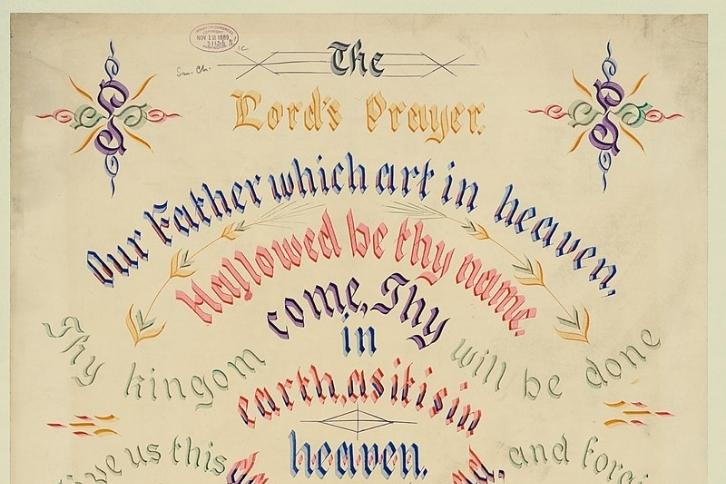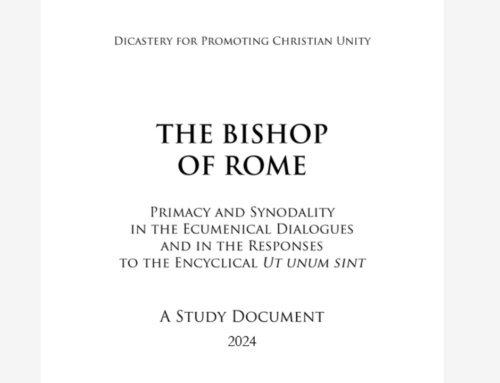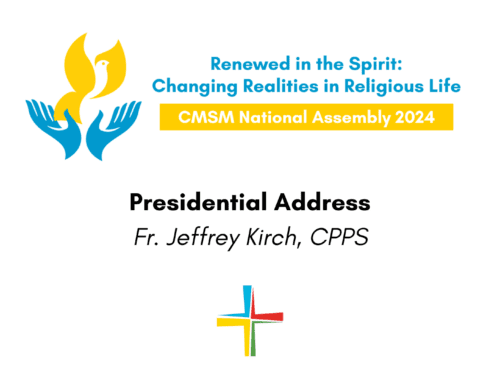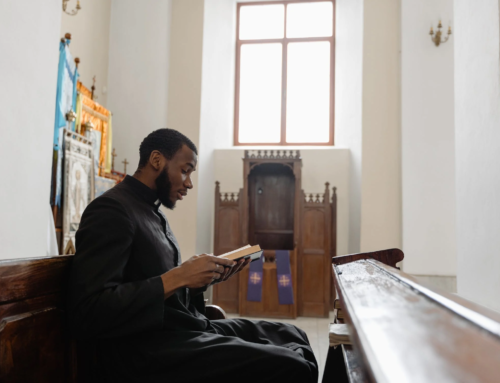Review for Religious is pleased to offer a new essay format: group book reviews on a single topic. We select topics which may be of interest to religious but are not specifically about religious life. For our inaugural bookshelf, biblical scholar Sr. Joan Cook, SC reviews a broad sampling of recent books on biblical studies. This is part 2 of our inaugural bookshelf; click here to view part 1.
Mahri Leonard-Fleckman: Ponder: Contemplative Bible Study, Year C. Collegeville: Liturgical Press, 2020. Pp. xi+299. $24.95.
This companion to the Catholic Lectionary for Year C is the third and final volume in Leonard-Fleckman’s series on the Sunday cycle of the Roman Catholic Lectionary. It is the outgrowth of Bible Study discussions she led in her parish. She explains that a very diverse group meets one evening a week for about an hour. Each week Leonard-Fleckman distributes a simple handout with the three readings and the response to the responsorial psalm, short background notes, and a section called Ponder with questions for ongoing reflection.
The book is a collection of these handouts for the Sundays of Year C, preceded by informative introductory material. She describes the Bible Study group, then explains the format of the book and thus of the Bible Study session. During the sessions, the hope is to remain focused on letting the text speak to the hearts and minds of the participants, toward the goal of union of heart and mind for the participants.
The process involves reading one of the upcoming Sundays’ three readings slowly and thoughtfully, then reflecting on it in the rhythm of lectio divina and Ignatian contemplation, which she explains as means to engage one’s heart. Then the group moves, at its natural pace, to a more intellectual discussion. This might take its start from the background notes included in the handout. The final step, Ponder, might occur at the end of the session, or might be a source of ongoing reflection throughout the week. After this introduction to the weekly sessions, the author includes helpful sections: “How To Use This Study – Groups” and “How To Use this Study – Individuals.” She then explains the pattern of three Readings and a Responsorial Psalm in the Catholic Lectionary for each Sunday, as well as the structure and rhythm of the Liturgical Year.
The readings and reflection materials for each Sunday follow. For example, the Ponder section for Easter Sunday invites the reader to enter into the disorientation and the mystery the women experienced at the empty tomb on that morning. Peter’s speech in the First Reading, and Paul’s letter to the Colossians, reinforce the mystery and the witness to which the feast calls us. Similar challenges for other Sundays give the reader the opportunity to enter more fully into God’s overwhelming love for us, and to respond wholeheartedly in our everyday lives. The reflections are general enough to appeal to a variety of readers, and particular enough to focus on the lessons and insights to be found in that particular Sunday’s readings.
Gerhard Lohfink: The Our Father: A New Reading. Translated by Linda M. Maloney. Collegeville, MN: Liturgical Press, 2019. Pp. x+115. $17.95.
In his Preface to the American Edition, Lohfink explains his hope that this little book will assist readers in understanding the Our Father and applying it to present-day situations. He highlights Jesus’ familiarity with what we know as the Old Testament; Jesus based the prayer on the words of the Scriptures that 1st century Jews heard in their Sabbath services. In chapter one Lohfink discusses the five principal characteristics of the prayer: first, it is pure petition; second, it is very short; third, it gets right to the point; fourth, God’s interest comes first; and fifth, God acts through people. He notes, in chapter two, that the prayer is primarily for Jesus’ disciples. He highlights the petition, “Give us this day our daily bread,” pointing out that it summarizes the entire prayer. ‘Daily bread’ is not meant to be read literally, unless a petitioner actually needs food, but rather as that which is most needed when the words are prayed.
Further chapters focus on various aspects of the other petitions in the prayer; for instance, the intimacy of the title “abba” and the difficulty it presents to those who see it as sexist, or whose experience of their father is not a happy one, and the stumbling blocks the prayer has presented for people throughout history. He points out that the first three petitions represent God’s point of view: Thy kingdom come, thy will be done on earth as it is in heaven. Lohfink discusses these in chapters five and six, “The Coming of God’s Reign” and “The Realization of God’s Plan.” All three have a basis in the Old Testament prophets. Ezekiel 36:19–28 asks God to bring together God’s people as one, with a new heart that is filled with the holy Spirit when we pray Hallowed be your name; Daniel 7:1–27 introduces the meaning of God’s Reign, that is, the beginning of God’s new world; Isaiah 55:10–11 highlights God’s saving action among us on earth.
Then the prayer turns to human concerns: “Forgiveness of Sins” in chapter seven focuses on the need for us to forgive unconditionally. Chapter eight, “Protection in the Time of Testing,” asks God to help us be faithful to our calling as God’s people. “Liberation from Evil,” chapter nine, focuses on our petition that God rescue us from the evils that surround us in the world.
Lohfink summarizes all the petitions in the very short chapter ten, “Desperate Cry and Confident Trust.” He points out that humanity needs God’s help to live according to God’s plan rather than our own projects. He then offers a reflective version of the prayer, to help us remember its power and intimacy as we pray it every day.
References and Acknowledgements conclude the book. Its short length echoes the short directness of the Our Father, in which every word contributes to the essence of the prayer. The book can serve as food for meditation on our relationship with God and one another. It can also be a helpful guide toward learning how integrally the Our Father is based on Jesus’ Jewish background, and on how faithfully the New Testament writers expressed the essence of Judaism in the light of Jesus’ teaching. It would make a welcome gift for someone in an RCIA program, or someone who wants to deepen their appreciation for God’s love in our lives.
Ronald W. Witherup: What Does the Bible Say About Old Age? Hyde Park, NY: New City Press, 2019. Pp. 134. $16.95.
This very readable book is part of the series “What Does the Bible Say About…” from New City Press. It discusses timely aspects of the aging process from various biblical perspectives.
An Introduction encourages the reader to have a Bible in hand in order to refer to passages from both the Old and New Testaments that shed light on each topic. Each chapter includes relevant biblical passages and discusses today’s understanding of the particular topic along with its inherent tensions, difficulties or complications. Each chapter concludes with questions for reflection that invite readers to relate the points in the chapter to their own reality.
The light-hearted titles of the chapters remind the reader not to take oneself too seriously, while the contents offer sound advice and insights on such topics as the respect that ancient people had for growing old; the tendency to prioritize youth and youthfulness; the reciprocity between the young and the elderly; and the wisdom of the elderly. For example, chapter three, “Experience Equals Wisdom… Or Does It?” points us to the biblical story of Susanna and the Elders in the book of Daniel 13:1–64. The story portrays the young Daniel, whose honest wisdom saves Susanna from the wiliness of the two Elders.
Other chapters discuss the connection between age and wisdom by telling stories of young people who are wise, and the importance of aging gracefully. Several biblical stories illustrate wise and heroic deeds of elderly people, the importance of intergenerational respect; the value of memories of ancestors and deceased spouses; the gift of generativity in old age; and the mystery of life after death. Chapter six, “When Old Age Makes Life Unbearable,” is particularly timely today, as more and more people wrestle with the possibility of euthanasia and choosing death. The question is heartbreaking for those who suffer from depression, discouragement or severe pain, and for those who love them. In our society that places such a high priority on taking control of our lives, the ethical dilemma has become torturous for many people. Several biblical stories illustrate the moral complexity of suicide and euthanasia. The book’s sensitive and insightful discussion offers valuable material for reflection, both for those who are elderly and those who love and care for them.
George M. Smiga with Little Rock Scripture Study staff: Angels in the Bible. Collegeville, MN: Liturgical Press, 2021. Pp. 110. $16.95. Bulk pricing available for groups.
Angels in the Bible is the latest publication created by Little Rock Scripture Study to supplement the biblical text and as a commentary. It includes an introductory section that explains how the book can enhance a study of Angels by groups or individuals; wrap-up lectures accessible online or on DVD; and on the importance of reading with Bible in hand, either the Little Rock Catholic Study Bible or another current translation of the Bible. It offers tips for preparation of group sessions and a suggested format for each of the six lessons in the book. Six lessons follow: “Studying Angels Is Studying God,” “Angels Before God’s Throne,” “Angels as Messengers of Joy and Guidance,” “Angels as Controlling Spirits of the Elements and Nations,” “Angels as Ministers of God’s Judgment,” and “Guardian Angels.” Each of these lessons includes a simple opening prayer, instructions to the leader to read the explanatory information about the topic, and nine or ten questions that focus on the information in the lesson; they also invite reflection on how the information is meaningful to today’s reader, and a closing prayer for personal use or as a conclusion to the session. The final section offers suggested steps for Praying With Your Group and Reflecting on Scripture.
The book can also be used by individuals for personal enrichment, prayer and study. A list of additional Scripture resources, including other books, is available at www.littlerockscripture.org.
Header image: “The Lord’s Prayer,” John Morgan Coaley, Public Domain, available at https://www.loc.gov/pictures/item/2004662429/






